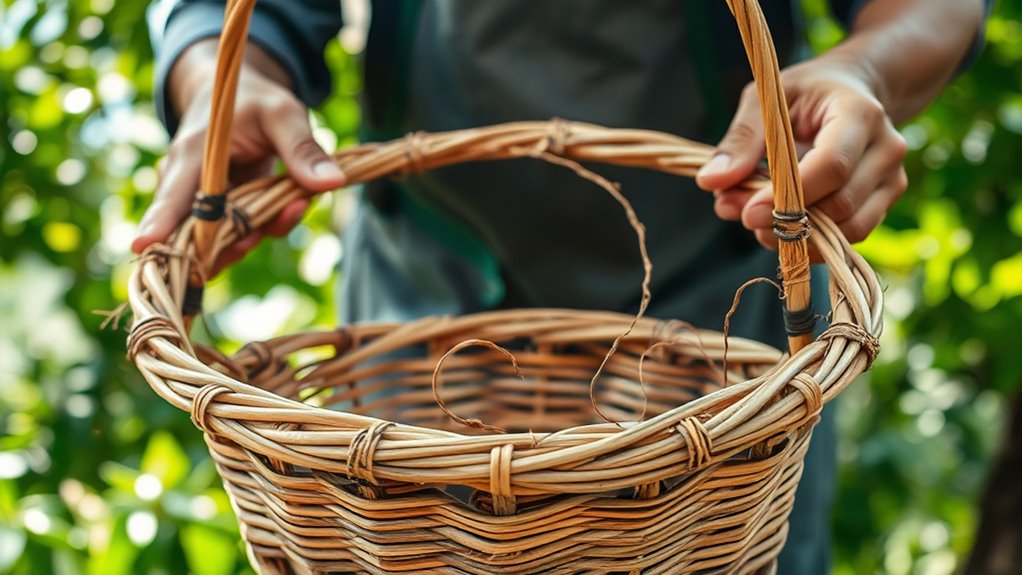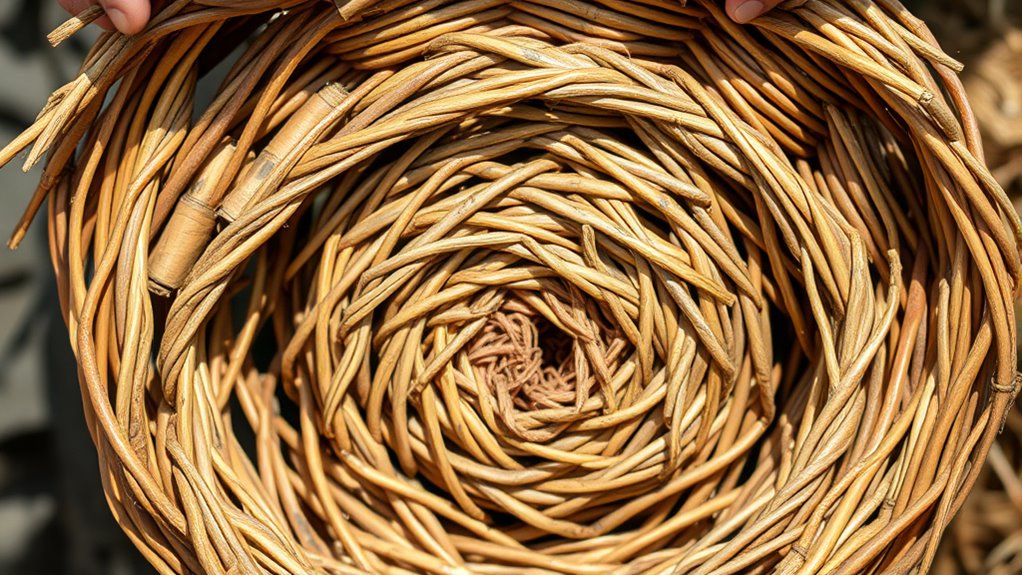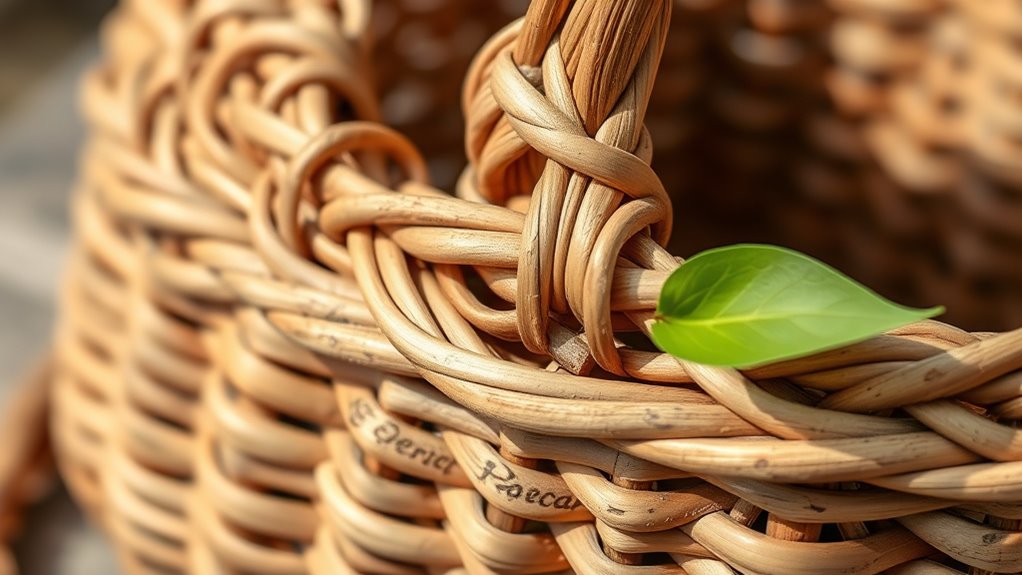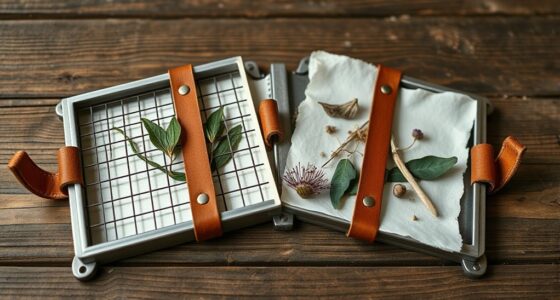To make a DIY foraging basket from willow branches, start by gathering flexible, green stems near water or moist areas in spring or early summer. Prepare the branches by removing excess leaves and small twigs, then craft a sturdy frame with straight stems. Weave the sides and base tightly, adding decorative touches and reinforcing stress points for durability. Keep your basket clean and dry after use. If you keep going, you’ll discover detailed steps to craft and care for your basket.
Key Takeaways
- Collect flexible, green willow branches during spring or early summer for easy weaving and durability.
- Create a sturdy basket frame using straight, horizontal stems arranged in a square pattern.
- Weave sides and base with consistent tension, incorporating decorative patterns if desired.
- Secure a handle by attaching a thick willow section to the rim and sides for easy carrying.
- Finish with reinforcement, smooth loose ends, and store in a dry, ventilated area to prolong lifespan.
Gathering and Preparing Willow Branches

To start gathering willow branches for your foraging basket, look for flexible, green or slightly woody stems near water sources or in moist areas. These locations often serve as essential wildlife habitats, so choose branches that are healthy and unbroken. Be mindful of seasonal timing; spring and early summer are ideal when willow shoots are tender and easy to bend. Avoid collecting during late fall or winter when branches are woody and less pliable. When harvesting, use clean tools to snip the branches, ensuring you don’t damage the plant unnecessarily. Prepare your willow by removing any excess leaves or small twigs, leaving only the main stems. This ensures your branches are ready for weaving and maintains the health of the plant’s habitat.
Crafting the Basket Frame

Once you have your willow branches prepared, start creating the basket frame by selecting a few sturdy, straight stems for the base. Arrange these stems in a square, ensuring they’re evenly spaced to define your basket’s dimensions. Use weaving patterns to secure the vertical and horizontal spokes, maintaining stability. Your chosen pattern impacts the basket’s strength and appearance. For example, a tighter weave offers more durability, while a looser pattern creates a rustic look. Keep in mind the overall basket dimensions to ensure it fits your foraging needs. Here’s a guide to help visualize the process:
| Basket Dimension | Weaving Pattern | Purpose |
|---|---|---|
| Small | Simple over-under | Compact, lightweight |
| Medium | Crisscross | Balanced strength and flexibility |
| Large | Tight weave | Heavy-duty, large capacity |
Additionally, selecting the appropriate weaving pattern can influence the basket’s overall stability, making it suitable for various foraging tasks.
Weaving the Sides and Base

As you begin weaving the sides and base of your basket, focus on maintaining even tension in your weaving material to keep the structure sturdy. Work steadily, ensuring each weave is snug but not overly tight. To add decorative patterns, alternate weaving over and under specific branches, creating visual interest along the sides. When attaching the handle, choose a sturdy section of willow and secure it tightly to the basket’s rim, weaving it into the sides for extra stability. Keep consistent spacing to maintain symmetry and prevent wobbling. This step shapes your basket’s foundation, blending functionality with aesthetic appeal. Take your time to ensure the weave is tight and even, setting a strong base for the final touches. Proper cookie management can help enhance your crafting experience by allowing you to customize your browsing preferences.
Finishing Touches and Reinforcements

Finishing touches and reinforcements are essential to guarantee your basket is both durable and attractive. Adding decorative accents, like wrapped willow or small embellishments, enhances its visual appeal. These accents give your basket a polished look while showcasing your craftsmanship. Functional reinforcements, such as extra bindings or cross-supports, strengthen the structure, especially at stress points like handles and the rim. Secure loose ends and ensure all weaving is tight to prevent unraveling. You might also reinforce the base with additional willow strips for extra stability. Incorporating reinforced bindings can further improve the basket’s durability under load. These steps not only improve the basket’s longevity but also make it more comfortable to carry. Combining decorative accents with practical reinforcements results in a finished product that’s both beautiful and sturdy, ready for your foraging adventures.
Caring for and Using Your Foraging Basket

To keep your foraging basket in good condition, you should regularly clean it to remove dirt and debris that can cause wear over time. Gently brush off soil and residue after each use, and occasionally wipe it with a damp cloth. Proper storage options help maintain its shape; store it in a dry, well-ventilated area away from direct sunlight. You can also add decorative embellishments like ribbons or painted details to personalize your basket, but avoid overly moist or harsh environments that may damage the willow. When not in use, consider hanging your basket or placing it on a shelf to prevent warping. Additionally, understanding the properties of willow branches can help you better care for and maintain the durability of your basket. With proper care, your foraging basket stays durable and attractive, ready for many adventures in the wild.
Frequently Asked Questions
Can I Use Other Types of Wood Instead of Willow?
You can definitely use alternative woods instead of willow, but consider their wood durability first. Some woods, like hazel or grapevine, work well because they’re flexible and sturdy. Avoid softer woods that can break easily. Always choose woods that can withstand outdoor conditions and frequent handling. With the right alternative woods, you’ll create a durable, functional foraging basket that holds up over time.
How Long Does It Take to Complete the Basket?
The weaving duration for your basket depends on your skill level and the complexity of the design. If you’re a beginner, it might take several hours over a couple of days, allowing for drying and adjustments. More experienced crafters can complete it faster, possibly within a few hours. Patience helps, especially if you’re learning new weaving techniques, so don’t rush—enjoy the process and take breaks when needed.
What Tools Are Necessary Besides Willow Branches?
Imagine crafting a song, each tool a note in harmony. Besides willow branches, you’ll need scissors or pruning shears to trim and shape, a knife for precise cuts, and optionally, pliers for bending or securing. Mastering basket weaving techniques requires patience and steady hands. These tools become your symphony, guiding you through the process, making your creation sturdy and beautiful. With them, you shape your basket just as a composer crafts a melody.
How Do I Prevent the Basket From Cracking Over Time?
To prevent cracking over time, you should focus on proper wood treatment and cracking prevention. Apply a natural sealant or oil, like linseed or tung oil, to protect the willow and maintain flexibility. guarantee your basket dries slowly in a well-ventilated area, avoiding direct sunlight. Regularly inspect for cracks, and reapply protective finishes as needed. Proper care and treatment keep your basket durable and crack-free for years.
Is It Safe to Forage Willow Branches From Wild Areas?
You might wonder if it’s safe to forage willow branches from wild areas. To guarantee wildlife safety, avoid harvesting near nests or habitats, and follow harvesting guidelines that promote plant health. Always identify the plant correctly, harvest sustainably, and respect local regulations. By doing so, you protect the ecosystem while gathering materials for your project. With careful foraging, you can enjoy sustainable use without harming the environment.
Conclusion
Now that you’ve crafted your willow basket, you’re ready to embrace the spirit of a true pioneer, just like the explorers of yore. Keep it well-maintained, and it’ll serve you for many adventures ahead. Imagine yourself in a medieval marketplace, carrying fresh foraged goodies with pride. With your new DIY skill, you’re not just creating a basket—you’re connecting with centuries of craft and tradition. Happy foraging, and may your basket always be filled with nature’s bounty!










